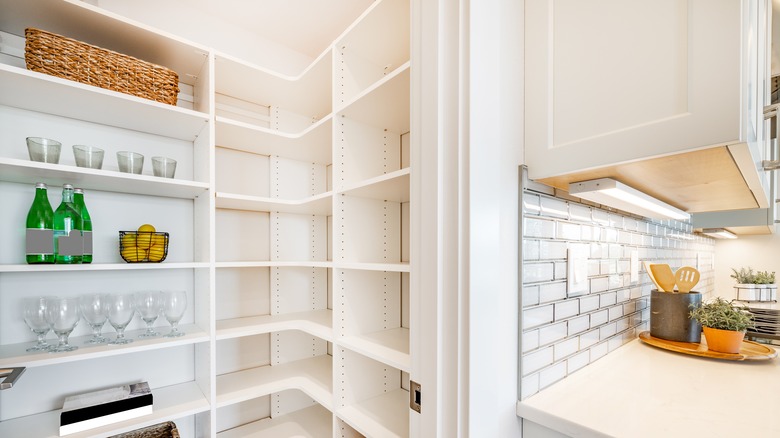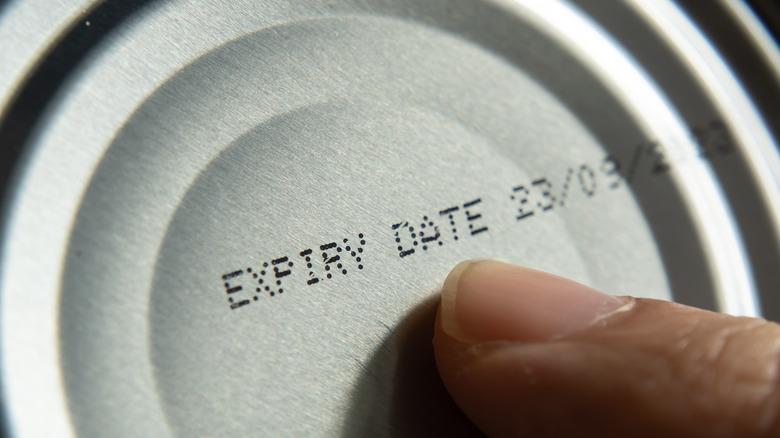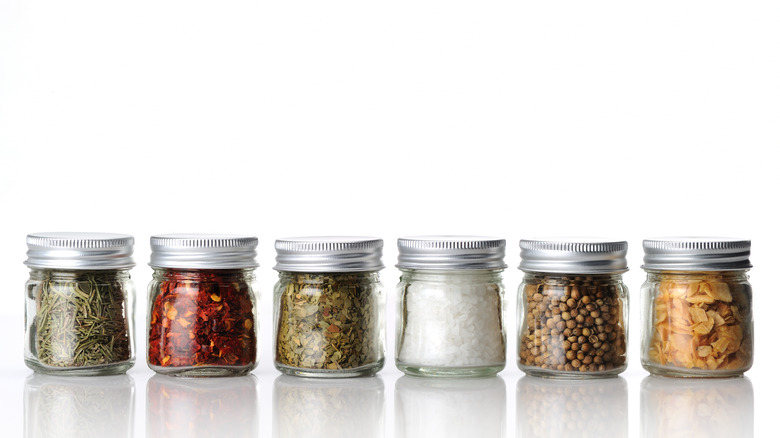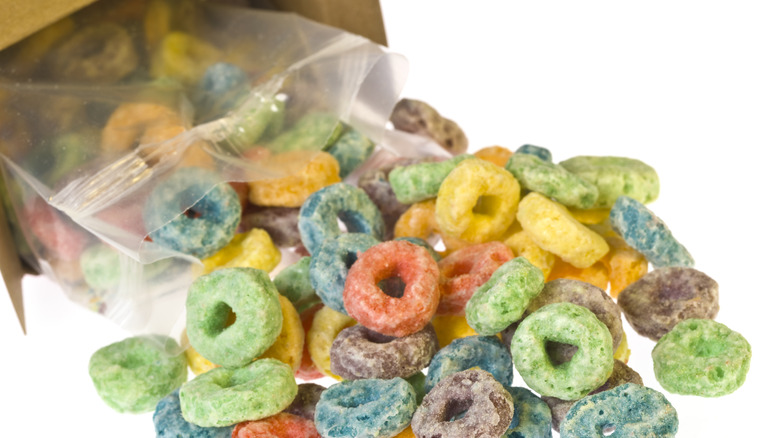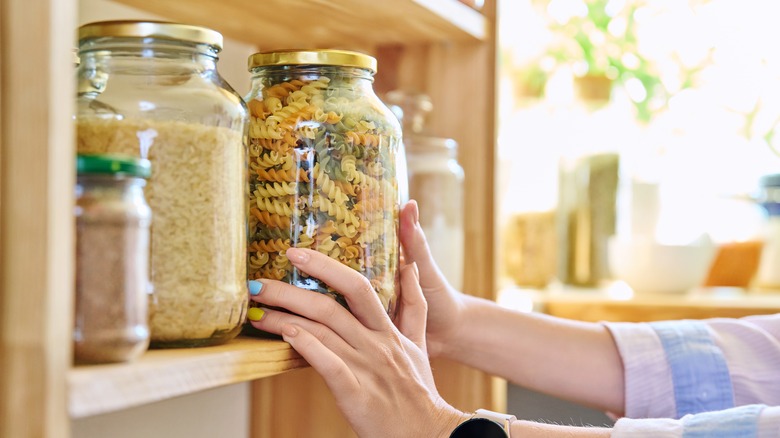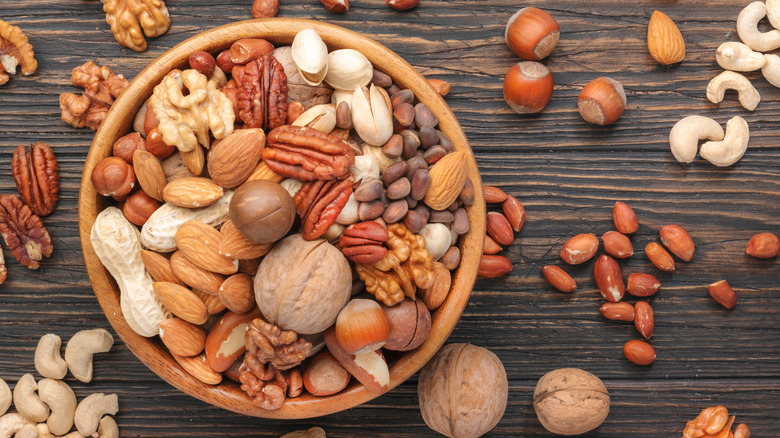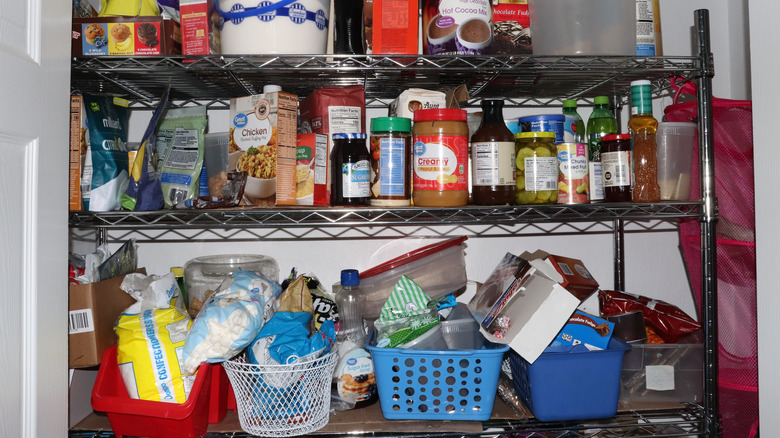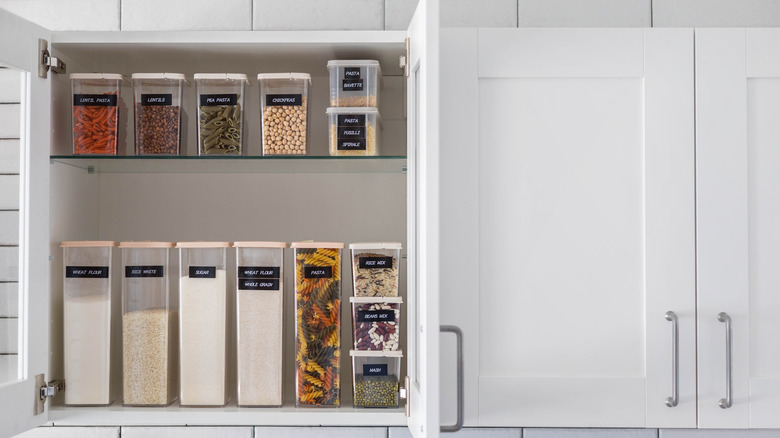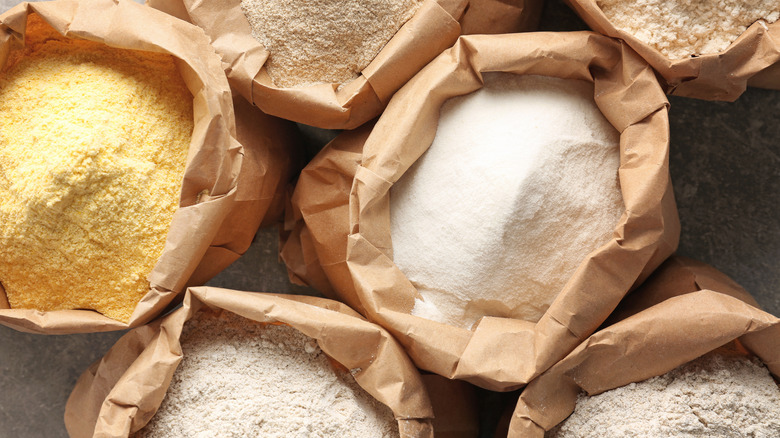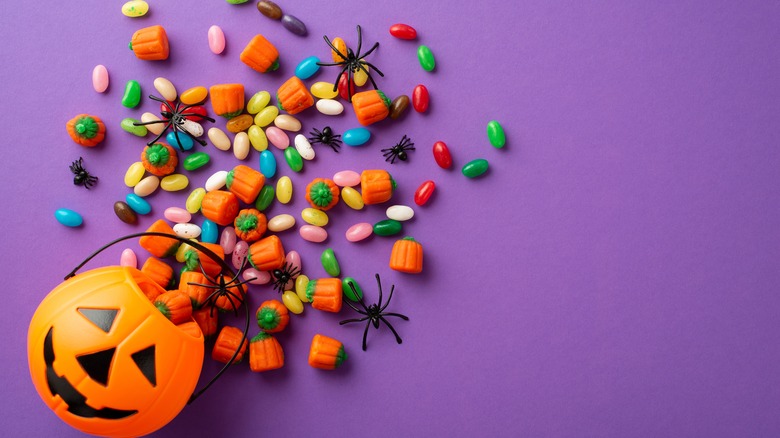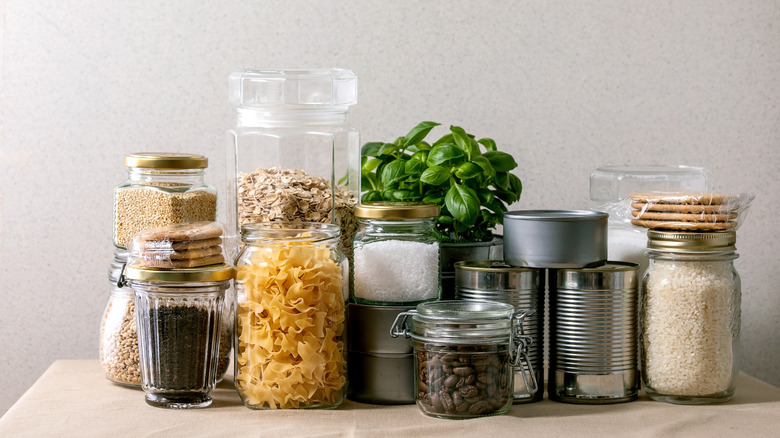11 Best Tips For Cleaning Out Your Pantry
Having a messy pantry is like having no pantry at all. Imagine setting out to prepare your meal on a busy and stressful weeknight and coming up against a reign of chaos, where everything is scattered to the four winds, and you can't find what you need to save your life. This isn't going to be conducive to a pleasant cooking environment.
Having a functional pantry is about more than just having the right ingredients — you also have to create a space that inspires you to whip up whatever meal you fancy. For pantry shelves with maximum space, picture neatly labeled jars, spices arranged by function, color, or whatever makes the most sense to you, and all your favorite staples stored in easily accessible locations. No mysterious jars of preserve sitting in a corner, no ingredients that are set to go to waste because they're hiding behind that ancient box of brown rice. Not only will this orderliness instill a sense of calm and control in you, but it will also help you save precious time. No more frantic searches for that elusive spice or rummaging through stacks of tuna, tomato, and God-knows-what cans to find the salt; with everything in its rightful place, you'll be able to locate what you need in the time it takes for your oil to heat up in your pan. But all of this doesn't come easy. First, you'll have to make a few changes, so let's talk about how to clean out that messy pantry and start fresh.
Throw away expired items
A chaotic pantry inevitably leads to items being pushed to the back, where they hide behind boxes of other unused foods and end up expiring before we even get a chance to open them up. You might not even remember what you have in there at the moment, so let's take a hypothetical look. Back in 2008, you bought a bottle of avocado oil out of curiosity, but then, when you brought it home, you had no idea how to use it. If it really has been 15 years, it's probably time to toss it.
Another thing to toss out is probably that baking powder you haven't used in months. Although it never goes bad per se, nor will it necessarily have an expiration date on its container, it will lose its potency and most of its rising power within 1-2 years. If you try to use baking powder after that timeframe, you may end up with a flat cake or overly dense cookies. And don't forget to check your canned goods as well. You may expect these to never expire, but canned tomatoes, for example, only last for about three years at the most due to their high acidic content.
Check your spices for freshness
How long do spices really last? While they might seem everlasting, spices tend to lose their effectiveness within one year or less. If you feel like you've added too much chili pepper to a recipe but can barely taste the bite, you're probably dealing with a de facto expired spice. While this move won't harm you, it certainly won't do anything to improve the flavor of your dish.
The best way to test for this before actually dumping your entire spice rack into a meal is to open up your jars and use your sense of smell. A fresh spice will hit you in the nostrils immediately, while a faded spice will leave you guessing whether your nose is still working. In the latter case, there is really not much you can do to revive your pantry item. A great way to bring out the freshness of spices is to roast them, but this is no guarantee. The best thing to do is toss it and make room for a fresh spice that will actually give flavor to your cooking. Remember, an excellent technique is to go heavy on the seasoning for slow cooker meals, where a lot of spices and seasoning are needed to withstand the long cooking hours.
Inspect open packages for staleness
Some packages in your pantry have probably not expired yet, at least not according to the date on the box. But you'll want to double-check that the box hasn't been opened at some point along the way. Even if the expiration date is far into the future, an open package differs from a sealed container. For example, an unopened box of graham crackers may remain fresh and crisp for up to nine months. Still, if the box and internal packaging are opened, you'll only have a few days to finish the contents before you're left with something that feels too stiff or too soggy. Either way, not good.
So, while you're checking every box, package, can, and bottle for their expiration dates, and as you're getting a little bit woozy sniffing on those possibly expired spices, don't forget to take the time to inspect your dry goods packs to see if anything has been secretly opened by a roommate, a sneaky family member, or yourself, during that midnight snack binge you obviously forgot about. And if you do find that open box, and the crackers are still usable, you can just throw together a simple graham cracker pie crust and make yourself a nice treat. You deserve it.
Take everything out and reorganize it according to usage
The easiest way to keep stock of your pantry and use everything you have is to organize it in a way that makes sense for your sensibilities and your cooking style. Maybe you reach for the smoked paprika more often than not, while the marjoram tends to be an afterthought. If this is the case, your smoked paprika should be front and center in your pantry, meaning on the middle shelf where you can grab it without searching for a ladder. Conversely, the marjoram should be on the top shelf to make room for the more sought-after spices below.
The simplest way to tackle this monumental task is to take everything out of your pantry and put it back in the correct new order. Each time you put a product on a shelf, consider how often you use it. A good rule of thumb is to think through your main go-to recipes and consider which ingredients they rely on. Once this is done, you'll notice a remarkable difference in how quickly you can put together a meal. You may even be so bold as to try new recipes. For example, if you have a treasure trove of chicken stock and cannellini beans, try this Instant Pot cassoulet, or use some dried herbs to make a savory granola bar snack.
Move foods that shouldn't be stored in a pantry
People tend to store all sorts of foods in their pantries, including items that have no place there. One common example is nuts, which may look pretty sturdy and non-perishable but can go rancid in just a few months, especially in hot, humid, or bright environments, and especially if they have a higher fat content. But this problem is easily solved. Remember — never store nuts in the pantry. Instead, store them in your fridge or freezer, where they can survive for a whopping two years.
Another surprising item that should not be in your pantry is that cold-pressed oil you picked up from the health foods store. The lack of heat and chemicals used to produce it help preserve the nutritional properties of the olives, but it also makes the oil more vulnerable to spoilage, either through mold growth, a dulling of the flavor, or both. The simple solution here is also to place the oil in the fridge. You will notice the liquid solidify in the cold, but this won't change the flavor or quality of your oil. Just take it out of the fridge a few hours before using it so that you won't have to dig it out of the bottle with a stick. It will soon return to its former liquid glory.
Wipe down the shelves and walls
After you've taken everything out of the pantry to reorganize it, remember to wipe down the shelves and walls before putting your items back in. You might not have noticed, but these surfaces will likely develop a grimy film over time, especially if your pantry is close to your stovetop. No matter how good and strong your hood is, grease particles will always escape into the air while you're cooking. Frying is the worst offender: When oil is heated to a high temperature, it emits polycyclic aromatic hydrocarbons, compounds known to cause respiratory distress, according to Dyson. And when this particulate matter isn't entering your lungs, it's falling and resting on your pantry shelves and other surfaces.
Another important reason for wiping down your pantry is to keep away pests that a spill might attract and end up infiltrating your foodstuffs. After months of shoving new food packages into your pantry, it's quite possible that your precious box of Pop-Tarts fell over and released all its sprinkles onto the shelf. You'll never know unless you start cleaning.
Clean it once every three months
We all have the best of intentions when it comes to our pantries. After the long and arduous task of emptying them and putting them in order, we always resolve to do better next time. To clean as we go, to throw something away as soon as it expires. But that's just not the reality of things. Life gets in the way, and sooner rather than later, the pantry ends up back where it started. This is why it is recommended that we clean our pantries every three months.
But don't worry. This doesn't have to take up your entire day. You can speed up the process by working your way down from up top; that way, if crumbs from the top shelf fall onto your middle shelf, you won't have to cover the same area twice. Next, we recommend vacuuming all those leaked crumbs before you start wiping. This will quickly remove the vast majority of dirt accumulating in your pantry. Lastly, consider using vinegar to tackle the layer of grime on your shelves. The substance is abrasive enough to get the job done but without harming your food with dangerous chemicals. And don't forget also to clean off the pantry items themselves. You may have cleaned that leaked honey off the shelf, but if you put the bottle back without wiping off the goo, it's just going to stick right back to the shelf.
Remove original packaging and store items in square containers
It can be inconvenient to store boxes of pasta, rice, quinoa, and other carbs next to each other. The packages come in different sizes and shapes, causing you to descend into a real-life Tetris scenario you'll never see the end of. You can solve this problem by taking all of your food items out of their packaging and installing them in square and rectangular containers. Simply label them and stack them on top of each other or side by side, and they won't yield so much as a wobble. In fact, the shape of the containers is no trivial matter. Round containers, which you may have already tried, tend to create a lot of negative space in a pantry, which is not ideal if you only have a small area to work with.
It's equally important that you choose see-through containers. This will give you a better idea of how much of something is left so that you don't come up against any unpleasant surprises when you find that you need four bouillon cubes but only have two left. Meanwhile, air-tight, square containers are unlikely to fall and release their contents all over your shelf. These babies will keep your pantry dust and debris-free. Plus, when you've emptied a container, you can simply pop it in the dishwasher and reuse it for whatever else you need.
Keep everything organized in groups
No one wants to spend hours looking for ingredients before they start cooking. At that point, it seems easier to just go out and buy them at the store. That's because most stores group everything in terms of food categories.
The fun part is that you can try this at home. For example, when you go to the store to get flour, you don't necessarily know where to find it right off the bat. But you do know that this is typically considered a baking material, so chances are, you're going to find your flour in the baking aisle. This sounds revolutionary to exactly no one, and yet many people don't apply this principle at home. We suggest doing so by coming up with categories that make sense to you and your particular needs. Aside from baking materials, category examples include pulses, such as beans, chickpeas, lentils, along with spices, pasta, rice, and canned vegetables. This style most closely mimics grocery store aisles. But you can also get creative, depending on your personal preference. For example, you could use a corner of your pantry to store only breakfast-related items such as oatmeal and pancake mixes. Or you could cordon off an area for quick weeknight meals, where you can store all the non-perishable ingredients for the meals you've planned out for the week, divided into their respective nights. This will ensure a high turnover of pantry ingredients, making it easier for you to clean everything in three months.
Do a seasonal sweep
We've all been guilty of holding onto Halloween candy for a bit too long. Maybe it got stuck behind the cans of lentils, or maybe it wasn't your favorite kind. Either way, if Halloween is in October and it's now July, it's probably best to get rid of that candy somehow. The way we see it, you have three choices: throw it away, give it away, or use it up in a single recipe in one fell swoop. If you choose the latter for handling your leftover Halloween candy, we have that recipe for you. It's called a piñata cookie, and you can make it by using a simple sugar cookie dough base and adding whatever candy you have on hand, whole or chopped up.
The same principle goes for any other holiday. If the season has passed, it's time to clear the pantry of that seasonal item. Leftover panettone from Christmas? Turn it into French toast with a twist by dipping slices of the Italian Christmas cake in your egg batter instead of regular bread. Leftover matzo sheets from Passover? Make a chocolate-matzo layer cake by dipping the sheets in coffee and layering them with chocolate mousse.
Use up expiring items
There's no point in wasting perfectly good food and the money you used to buy it when there's a whole world of new and unusual recipes out there that can help you use up your expiring pantry goods over the course of a week or less. Let's go back to that avocado oil from the beginning, for example. If it's only been in your pantry for a year or two, you might be able to use it up before it goes bad, even if it's a little past its expiration date (as long as it doesn't smell rancid). Simply use avocado oil to saute your vegetables instead of olive oil. It behaves in much the same way and is considered to be just as healthy as olive oil.
Similarly, if you're stuck with ancient-but-still-good chickpeas, try mashing them into hummus or popping them into your Moroccan linguini. Or if you think you have too much pasta in your pantry, you can use some of it up in a quick mac and cheese recipe with chicken-apple sausage and plenty of cheeses. The recipe also calls for flour and hard cider, so you should be well on your way to using up those pantry items. And yes, you can also finally use those kidney beans in this delectable recipe for Ghormeh Sabzi, a Persian dish that also calls for your slowly flagging turmeric and those dried fenugreek leaves you never thought you'd actually use.
